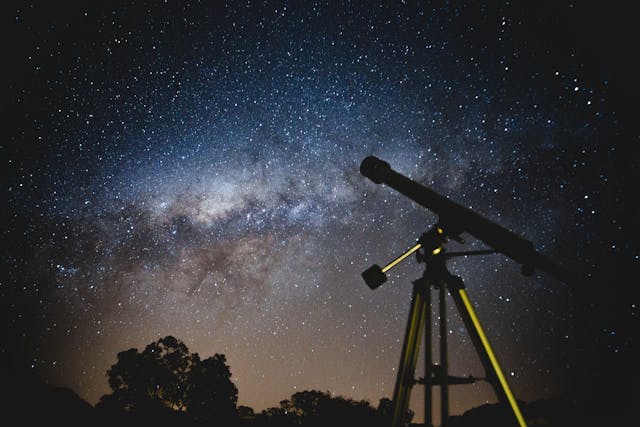
How does a telescope work? They used to use lenses, but modern telescopes use mirrors.
The first telescopes used lenses in the same way that a camera or a magnifying glass does. The first telescope was made by Hans Lipperhey, a German-Dutch spectacle maker. He used lenses to make glasses and he knew that concave lenses take light and curve it outwards, while convex lenses take light and curve it inwards. With glasses, concave lenses are used for people who are near sighted, because the light focuses behind their retinas and the lens corrects it. Convex lenses are used for people who are far sighted because the light focuses in front of their retinas and the lens corrects it. He realized that if he put a concave lens and a convex lens together, he could see things that were very far away. He put the convex lens at the wide end of a tube and the concave lens at the narrow, eye end of the tube. The light comes in through the neck of the telescope and it is focused by the convex lens. The light hits the concave lens, which curves the light outwards, magnifying it. By lengthening or shortening the tube, he could change where the light focused and see things at different distances more clearly. This was a refracting telescope. Galileo was the first person to use this kind of telescope to look at space and he made many observations using it.
The refracting telescope works by angling light through lenses. It worked, for all intents and purposes, but there are some problems with refracting telescope. The first problem is that to see things from further away, you need thicker lenses. If you think about someone with very bad eyesight, they need thicker lenses than someone with slightly bad eyesight. This is the same with a telescope. Thicker lenses are harder to make and they are heavier. The second problem is that the lenses have to be the perfect shape and free of imperfections because the light passes through the lens. It is very difficult to blow, mill and polish glass that perfectly. Any defects, air bubbles, bits of dust or sand, or other imperfections in the lens will ruin its effectiveness. A third problem is that different wavelengths of light get refracted by a slightly different angle as they pass through the lens. This is the reason why you can use a prism to divide white light into a rainbow of colors. This slight difference in the angle of each color meant that all the colors focused in slightly different places, giving something called chromatic aberration, or basically color distortion.
The solution to all of these problems was the reflecting telescope. It was invented by James Gregory, but first built by Isaac Newton in 1688. The refracting telescope refracts (bends) light. The reflecting telescope reflects light. The solution to the lens problem was to reflect light with a curved mirror. Mirrors are much easier to make and shape than lenses. They are lighter, which meant telescopes could be more compact. They are cheaper and they only have one side that needs to be protected. They are very smooth and can be angled fairly easily. Light comes in through the neck of the telescope, it hits the mirror at the bottom of the telescope, which is angled to focus all of the light in exactly the same place on a small mirror, which reflects the light out of an eye piece.
In the 1930s, a new type of telescope called a catadioptric telescope was invented. They combined a mirror with a lens and they are the most common type of telescopes used by amateur astronomers at the moment. They use a mirror to reflect the light and a lens to focus and magnify it. They are cheaper to manufacture and can be smaller than all refracting or all reflecting telescopes.
The telescopes that we send into space use mirrors because they are much lighter, easier to make, and they can be folded up, which is necessary if you are launching something into space. In space, the mirrors can be much larger as well, which is important because the size of the mirror dictates how much light the telescope can gather. The mirror on the James Webb Space Telescope is 6.5 meters across, with a collecting area of 25.37 m2. The mirror is made out of beryllium, which is a very light and strong metal. It keeps its shape at very low temperatures, which is necessary for outer space. The light hits the mirror and gets reflected onto a secondary mirror, which then reflects it back onto the scientific instruments that make up most of the telescope. And this is what I learned today.
Photo by Lucas Pezeta: https://www.pexels.com/photo/black-telescope-under-blue-and-blacksky-2034892/
Sources
https://spaceplace.nasa.gov/telescopes/en
https://webbtelescope.org/contents/media/images/4199-Image
https://www.fortworthastro.com/beginner5.html
https://en.wikipedia.org/wiki/Hans_Lipperhey
https://en.wikipedia.org/wiki/Catadioptric_system
https://webbtelescope.org/news/webb-science-writers-guide/telescope-overview
